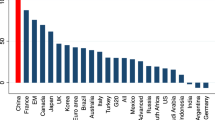Abstract
This paper examines the effect of government policies on the financing decisions of firms in China. A real options model is developed to understand how fiscal and monetary policies affect corporate leverage. The model predictions will be tested with a comprehensive panel data set spanning from 2002 to 2011. This work documents robust evidence that show the positive association of both tax and risk-free rate with firm leverage: increase in tax rate and risk free rate by one standard deviation results in the increase in corporate leverages by 0.61 to 1.06 percent and 2.54 to 3.68 percent, respectively. In addition, the productions of the firms are not affected by the tax rate in the short run, and the firms are operating in their optimal market leverage. The implied tax rate and risk free rate are solved by assuming that the firms achieve their optimal leverages. The implied tax rate declines with the size, whereas the opposite goes for implied risk-free rate.
Similar content being viewed by others
References
Baker, M. & Wurgler, J. (2002). Market timing and capital structure. The Journal of Finance, 57(1): 1–32
Bradley, M., Jarrell, G. & Kim, E.H. (1984). On the existence of an optimal capital structure: theory and evidence. The Journal of Finance, 39(3): 857–878
Cornell, B. & Shapiro, A.C. (1987). Corporate stakeholders and corporate finance. Financial Management, 16(1): 5–14
Cornett, M. & Travlos, N. (1989). Information effects associated with debt for equity and equity for debt exchange offers. The Journal of Finance, 44(2): 451–468
Devereux, M.P. & Griffith, R. (1998). Taxes and the location of production: evidence from a panel of US multinationals. Journal of Public Economics, 68(3): 335–367
Fama, E.F. & French, K.R. (1998). Taxes, financing decisions, and firm value. The Journal of Finance, 53(3): 819–843
Fan, J.P.H., Wong, T.J. & Zhang, T. (2007). Politically connected CEOs, corporate governance, and post-IPO performance of China’s newly partially privatized firms. Journal of Financial Economics, 84(2): 330–357
Fernald, J. & Rogers, J.H. (2002). Puzzles in the Chinese stock market. The Review of Economics and Statistics, 84(3): 416–432
Giannetti, M. (2003). Do better institutions mitigate agency problems? Evidence from corporate finance choices. The Journal of Financial and Quantitative Analysis, 38(1): 185–212
Goldstein, R., Ju, N. & Leland, H.E. (2001). An EBIT-based model of dynamic capital structure. The Journal of Business, 74(4): 483–512
Harris, M. & Raviv, A. (1991). The theory of capital structure. The Journal of Finance, 46(1): 297–355
Haugen, R.A., Stroyny, A.L. & Wichern, D.W. (1978). Rate regulation, capital structure, and the sharing of interest rate risk in the electric utility industry. The Journal of Finance, 33(3): 707–721
Huang, G. & Song, F.M. (2006). The determinants of capital structure: evidence from China. China Economic Review, 17(1): 14–36
Jin, Y. (2005). Institutional interpretation of wage inequality in industries. Statistical Research (in Chinese), 22(4): 10–15
Leland, H.E. (1994). Corporate debt value, bond covenants, and optimal capital structure. The Journal of Finance, 49(4): 1213–1252
Lemmon, M.L., Roberts, M.R. & Zender, J.F. (2008). Back to the beginning: persistence and the cross-section of corporate capital structure. The Journal of Finance, 63(4): 1575–1608
Liu, Q. & Wong, K.P. (2011). Intellectual capital and financing decisions: evidence from the U.S. patent data. Management Science, 57(10): 1861–1878
Modigliani, F. & Miller, M.H. (1958). The cost of capital, corporation finance and the theory of investment. The American Economic Review, 48(3): 261–297
Morellec, E. (2001). Asset liquidity, capital structure, and secured debt. Journal of Financial Economics, 61(2): 173–206
Porter, M.E. (1979). The structure within industries and companies’ performance. The Review of Economics and Statistics, 61(2): 214–227
Rajan, R. & Zingales, L. (1995). What do we know about capital structure? Some evidence from international data. The Journal of Finance, 50(5): 1421–1460
Schroeter, J.R. (1988). Estimating the degree of market power in the beef packing industry. The Review of Economics and Statistics, 70(1): 158–162
Taggart Jr., R.A. (1977). A model of corporate financing decisions. The Journal of Finance, 32(5): 1467–1484
Titman, S. & Wessels, R. (1988). The determinants of capital structure choice. The Journal of Finance, 43(1): 1–19
Tserlukevich, Y. (2008). Can real options explain financing behavior? Journal of Financial Economics, 89(2): 232–252
Wang, H. & Qian, C. (2011). Corporate philanthropy and corporate financial performance: the role of stakeholder response and political access. Academy of Management Journal, 54(6): 1159–1181
Wu, L. & Yue, H. (2009). Corporate tax, capital structure, and the accessibility of bank loans: evidence from China. Journal of Banking & Finance, 33(1): 30–38
Zattoni, A. (1999). The structure of corporate groups: the Italian case. Corporate Governance: An International Review, 7(1): 38–48
Author information
Authors and Affiliations
Corresponding author
Additional information
Kunyuan Qiao is a graduate student in Economics at Guanghua School of Management, Peking University, Beijing, China. His major is industrial economics, and his research interests include corporate finance, financial econometrics, econometrics, and applied econometrics. He is currently a teaching assistant at Peking University and member of the Society for the Study of Emerging Markets. He serves in the editorial board for the European Journal of Science and Engineering, European Journal of Mathematics and Statistics, and so on, and has refereed papers for China Economic Quarterly, Quarterly Journal of Finance (Journal of Chinese Finance Annual Meeting) and Review of Investment Studies. He has published papers in international journals such as Frontiers of Economics in China, as well as journals in Chinese such as Economic Science, Journal of Finance & Economics. He is the winner of the Innovation Scholarships in Peking University for two consecutive years.
Rights and permissions
About this article
Cite this article
Qiao, K. Government policies and corporate financing decisions in China: Theory and evidence. J. Syst. Sci. Syst. Eng. 22, 93–111 (2013). https://doi.org/10.1007/s11518-013-5207-8
Published:
Issue Date:
DOI: https://doi.org/10.1007/s11518-013-5207-8




